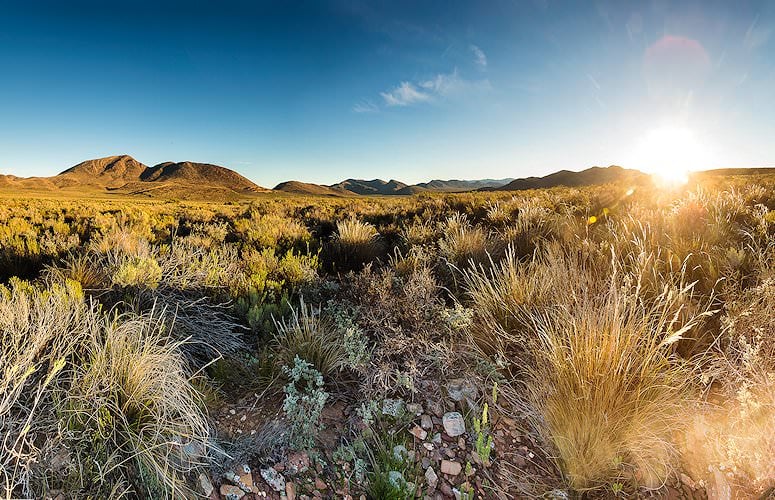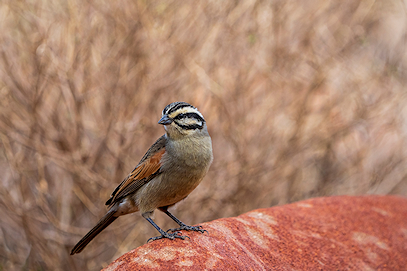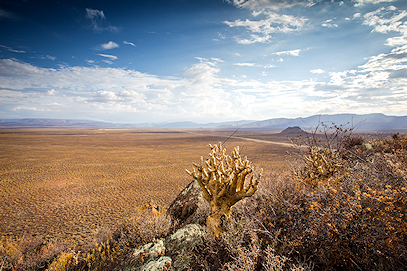South Africa's Tankwa Karoo National Park
Help Me Plan- Home
- >
- African Travel
- >
- South Africa
- >
- National Parks
- >
- Tankwa Karoo National Park
Tankwa Karoo National Park Destination Guide
Tankwa Karoo National Park protects a starkly beautiful slice of the Succulent Karoo, one of the world’s biodiversity hotspots. Straddling the southern edge of the Northern Cape, it unfolds in vast gravel plains, sculpted escarpments, and big skies. Visitors come for solitude, superb stargazing, seasonal wildflower displays, and rewarding birding across remote, rugged terrain.
Getting There
By Air: The nearest airport to Tankwa Karoo National Park is Cape Town International. Guests will be met at OR Tambo in Johannesburg and assisted with boarding a flight to Cape Town. The short flight offers views of the Karoo on a cloudless day, so try to sneak a peek out the window if you can. You will be driven directly to the park or your first destination in the Western Cape from Cape Town.
By Road: The Great Karoo stretches hundreds of miles over central South Africa, and getting to Tankwa Karoo National Park requires an almost five-hour scenic drive from Cape Town, with magnificent views of the arid landscape. Guests will be transported to the park in an air-conditioned vehicle from either the airport or their previous tour destination.
Weather & Best Time To Visit
The Tankwa Karoo is an arid area. The word “Tankwa” is Khoisan for “land of thirst” — which hints at the area’s climate. It is one of the driest regions in South Africa. Be sure to pack warm clothes, though — little rain does not mean it does not get cold, especially in winter.
The days tend to get extremely hot, rising to almost 40 °C in the summer months (December through February). During winter, temperatures drop, and once the sun sets, it can be freezing. Days are more comfortable than in the blistering summer months and are often less windy.

Tankwa Karoo National Park protects one of the most starkly beautiful tracts of the Karoo and is well worth visiting for several reasons, among them its moon-like landscape, diversity of succulent plants, and fine Karoo birding. On night drives you may be surprised to find aardvark in notable numbers. Though the remarkable endemism and diversity of the Succulent Karoo flora (spectacular from August to October) is its most renowned aspect, the Karoo also offers much to the birder.
Reasons to visit Tankwa Karoo National Park
Take a Break
The park allows visitors to truly break away from busy lives and enjoy an African safari experience in an area largely unscathed by development. There are no restaurants, shops, or ATMs in the park. We ensure you have everything you need before arrival so you can enjoy your time — worry-free.
Reaching for the Stars
As the area is far from large cities, you will see the stars very clearly. It is rare to see the Milky Way, Orion’s Belt, or the Southern Cross as brightly as you can while stargazing in this national park. The Southern African Large Telescope (SALT) also lies in the Karoo, near the town of Sutherland.
On Your Own Time
The park does not offer organized tours. You can head out in search of wildlife and birdlife and take in nature at times that suit you, for as long as you like. African Sky ensures you are comfortable in an air-conditioned vehicle with an expert guide. There are no official hiking routes, so explore with care.
Experiences to Savor at Tankwa Karoo National Park
When visiting Tankwa Karoo National Park, travelers relish the otherworldly solitude and silence. Far removed from the din of civilization, senses heighten, sharpening appreciation for the smaller things.

Pace Yourself
You set the pace on self-drive game viewing in a private, air-conditioned vehicle. Your African Sky guide can drive you in search of wildlife at your preferred tempo.
Bird Watching
With roughly 187 bird species recorded, including several endemics, the park is a rewarding destination for any birder.
Scenic Viewpoints
Views in Tankwa are singular and memorable, especially from vantage points like Gannaga Pass and Elandsberg.Useful Information
History
It is hard to believe that the Great Karoo once overflowed with water. Carbon dating and archaeological evidence indicate that this area was a vast inland sea hundreds of millions of years ago. Tankwa Karoo National Park was proclaimed in 1986 and added to the South African National Parks portfolio. The conservation area grew from about 27,064 hectares to roughly 146,373 hectares through subsequent land additions. The Bushmen first inhabited it, followed by Khoe pastoralists who moved livestock with wildlife migrations.
In the 1700s, Trekboer settlers began using the area for grazing, though the arid land proved challenging for cattle. Overgrazing damaged the soil, and the park was initially closed to the public. Since proclamation, conservation of endemic fauna and flora has been the main focus. South African National Parks prioritized the area by acquiring high-biodiversity land and surrounding farms to enlarge the conservation area to its current extent.
Wildlife
Smaller mammals, such as the steenbok and klipspringer, and larger antelope, including Cape mountain zebra, grey rhebok, kudu, springbok, and eland, reside in the park and are most common in the eastern reaches. Various antelope species were reintroduced to restore the natural ecology, and some animals — including gemsbok, red hartebeest, and springbok — were fitted with radio collars to monitor movements.
The reintroduction program started in June 2004 with Cape mountain zebra, gemsbok, red hartebeest, and springbok, with further springbok and eland added between 2010 and 2012. An aerial game census in 2013 indicated that animals had reproduced and spread across the park. You might even spot the elusive leopard. Over 180 bird species frequent the region; birders should also watch for Verreaux’s eagle.
Vegetation & Terrain
Tankwa Karoo National Park is situated in the Great Karoo, a vast semidesert that receives too much rainfall to be a true desert. It falls within the Succulent Karoo Biodiversity Hotspot, one of the world’s richest and most threatened reservoirs of plant life, and is home to exceptionally diverse succulent flora.
Vegetation types include the Central Tanqua Grassy Plain, Roggeveld Shale Renosterveld, Tanqua Escarpment, Succulent Karoo, Roggeveld Karoo, Tanqua Wash Rivers, and Nieuwoudtville Roggeveld Dolerite Renosterveld. Approximately 1,500 plant species occur only in the Succulent Karoo biome, and the display after seasonal rains draws many visitors.
Activities
The self-drive game drive is the most common activity in Tankwa Karoo National Park, letting you observe animals, bird species, and plants at your own pace. Collect a current species list at reception to know what to look for. Two 4x4 routes — the Leeuberg 4x4 Eco-trail and the Watervlei 4x4 Route — are available; other off-road tracks should be attempted only by experienced drivers. Gannaga Pass and Elandsberg viewpoints are easily accessible.
Bird watching is popular, with the annual Tankwa Birding Bonanza held in April. Oudebaaskraal Dam is a favored spot for waterfowl. Altogether, around 187 bird species are recorded, with several endemics, so pack binoculars. Hiking and cycling are permitted but not on marked trails; exercise caution and keep to roads for safety. The vast landscape offers excellent photographic prospects.









